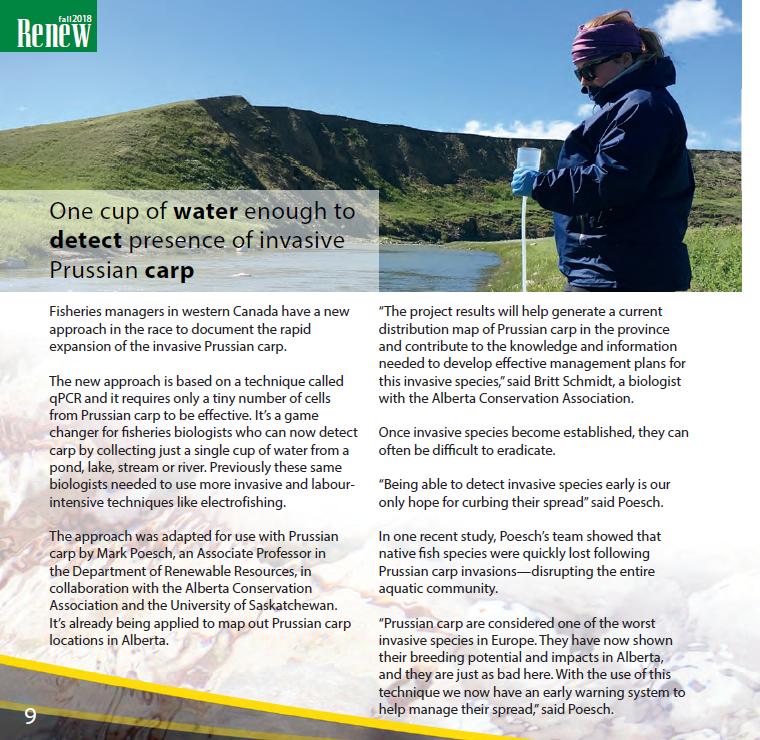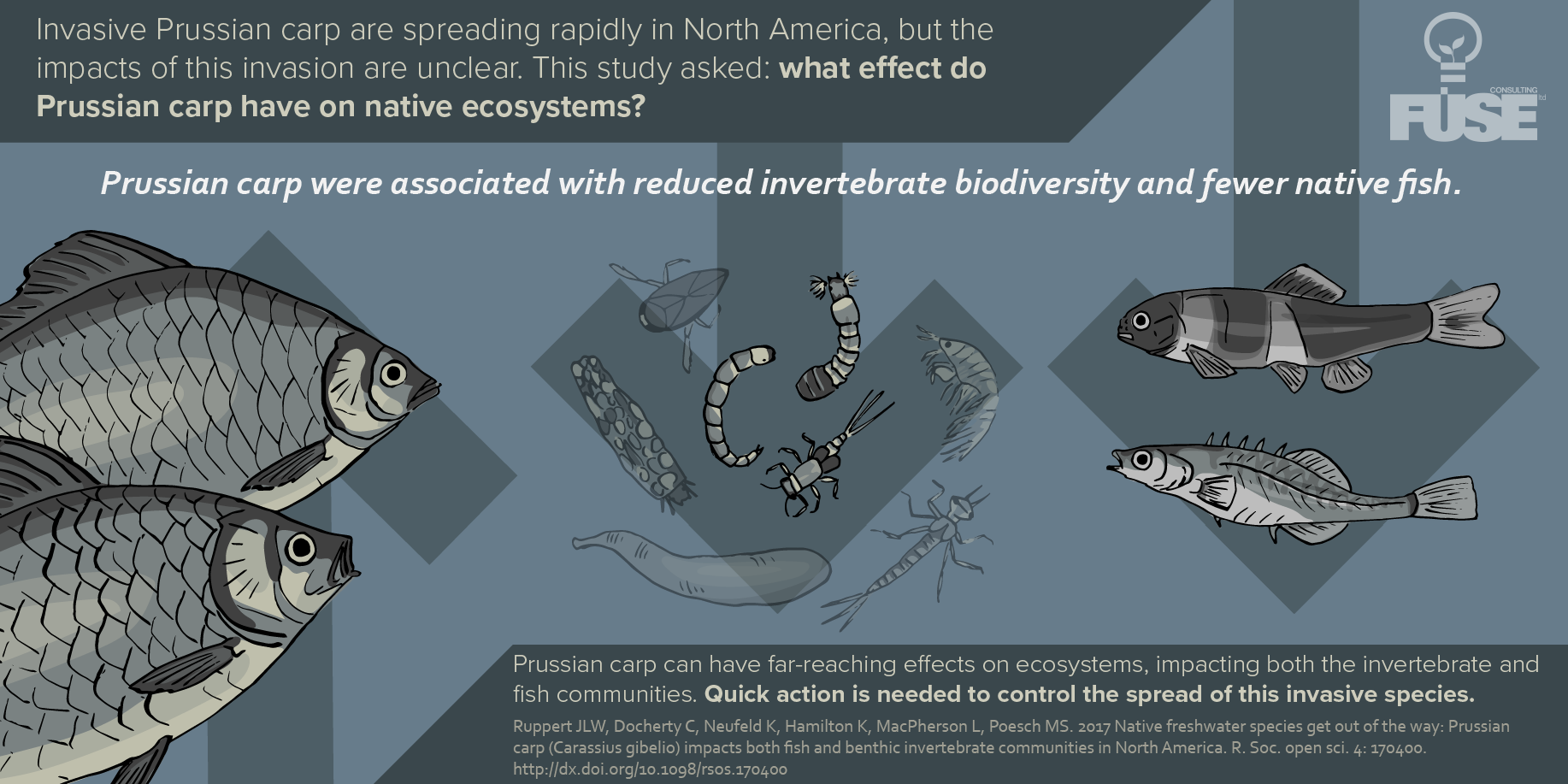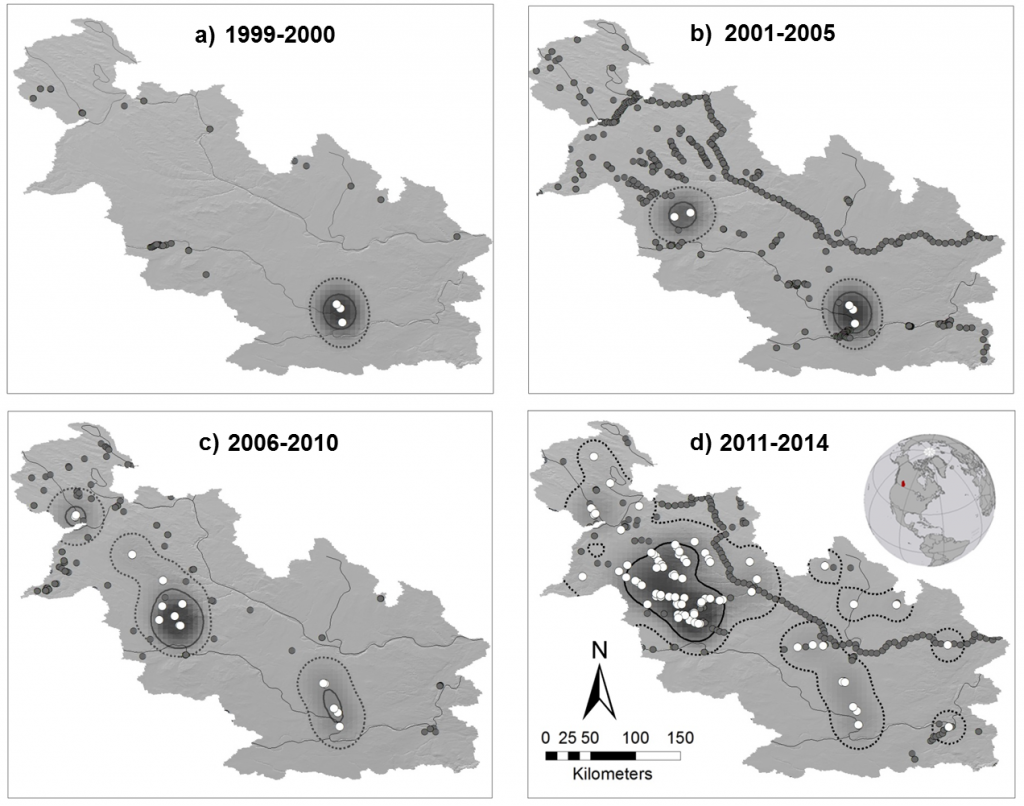PoeschLab research on eDNA on Prussian Carp highlighted in Renew Magazine.

Invasive species are recognized as one of the largest extinction threats to freshwater fishes. Invasive species are estimated to have a combined cost of $314 billion USD annually due to damages such as maintenance to infrastructure, and lost revenue from recreational fisheries. Prussian Carp are one of the most noxious non-native species in Eurasia. Recently, Prussian Carp were genetically confirmed in Alberta, Canada. Dr. Poesch and his team have been studying Prussian Carp in Alberta since 2013. Our findings show that Prussian Carp are rapidly expanding in Alberta (doubling their range every five years), that they are already significantly impacting freshwater fish and invertebrates (Ruppert et al. 2017), and that have similar characteristics as Asian Carp, one of the worst invaders in the continental United States (Docherty et al. 2017).
PoeschLab research on eDNA on Prussian Carp highlighted in Renew Magazine.

PoeschLab member Jesse Shirton interviewed on our research on Prussian Carp. Link to article: ‘Cottage Life’
Also Read:
It was a great honour to give a plenary talk on freshwater invasive species and participate in a panel discussion with Dr. Daniel Simberloff (University of Tennessee), Dr. Chris Thomas (University of York, UK), Jason Fisher and Margo Pybus at this year’s Alberta Wildlife Society meeting in Lethbridge. I really enjoyed the discussion on invasive species! I was also very impressed to see as many as five undergraduate students from my Fish and Wildlife class in attendance! Also happy to see my students Sebastian Theis (PhD candidate), Jesse Shirton (undergraduate) and Jamie Card (undergraduate) present posters on their research!
Abstract:
Prussian carp (Carassius gibelio) are one of the most noxious non-native species in Eurasia. Recently, Prussian carp, a nonnative freshwater fish species, were genetically confirmed in Alberta, Canada and have been rapidly expanding their range in North America since establishment. Given their rapid range expansion, there is an increasing need to determine how Prussian carp may impact native species. We assessed the severity of the Prussian carp invasion by (i) determining their impact on fish communities, (ii) assessing their impact on benthic invertebrate communities, (iii) evaluating if Prussian carp alter abiotic conditions, and (iv) identifying where we find higher abundances of Prussian carp. When Prussian carp were established, we found significant changes to the fish community. Correspondingly, the degree of impact to benthic invertebrate communities was related to the stage of invasion (none, early or recent), where changes in fish communities were significantly concordant with changes in benthic invertebrate communities. Finally, we found that higher abundances of Prussian carp were significantly associated with lower abundances of a majority of native fish species. Altogether, using three lines of evidence, we determine that Prussian carp can have wide-ranging impacts on freshwater ecosystems in North America, pressing the need for management intervention.
Citation: Ruppert, J.L.W.*, Docherty,C.*, Rudolfsen, T.*, Neufeld, K.*, Hamilton, K.*, MacPherson, L. and M.S. Poesch. (2017) Native North American freshwater species get out of the way: Prussian Carp (Carassius gibelio) establishment impacts both fish and macroinvertebrate communities. Royal Society Open Science 4: 170400.

Also Read:
*Lab members: Jonathan Ruppert, Cassandra Docherty, Tyana Rudolfsen, Kenton Neufeld, Kyle Hamilton, Mark Poesch. Check out opportunities in the lab!
Abstract:
Prussian Carp (Carassius gibelio Bloch, 1782) is one of the most successful invasive species in Eurasia. Recently, Prussian Carp were genetically confirmed in Alberta, Canada, documenting the first detection of this species in North America. Given the close morphological similarity to their sister species, the Goldfish (Carassius auratus Linnaeus, 1758), it is likely that this species has been undetected for some time. We document the spread of Prussian Carp since arrival (circa 2000), and contribute a trait-based risk assessment to potential recipient communities in western North America. Using a meta-analysis of geo-referenced fisheries data in conjunction with original sampling in 2014, we show that the Prussian Carp range has increased by eight- to eleven-fold over 15 years in Alberta at a rate of approximately 233–1,250 km2 per year. Range expansions in the near future are possible through the Saskatchewan River drainage and south into the Missouri River basin, with easily accessible routes to Midwestern North America through irrigation canals. We show high life history trait overlap with other successful invasive species, such as Goldfish and Common Carp (Cyprinus carpio Linnaeus, 1758). Additionally, there was high life history trait overlap with several species of native sunfish (Centrarchidae) and suckers (Catostomidae). This study highlights Prussian Carp’s potential to widely impact North American freshwater ecosystems and to successfully compete with native taxa. Considered one of the worst invaders in Eurasia, the arrival of Prussian Carp in North America poses serious concern for fisheries managers. There is an urgent need to develop management plans before further range expansion and disruption of freshwater ecosystems by this new invasive species.
Citation: Docherty, C.*, Ruppert, J.*, Rudolfsen, T.*, Hamann, A., and Poesch, M.S. 2017. Assessing the spread and potential impact of Prussian Carp (Carassius gibelio Bloch, 1782) to freshwater fishes in western North America. BioInvasions Records 6: 291-296.
Spread of Prussian Carp in Alberta, Canada

Also Read:
*Lab members: Cassandra Docherty, Jonathan Ruppert, Tyana Rudolfsen, Mark Poesch. Check out opportunities in the lab!
Abstract:
The round goby (Neogobius melanostomus) first invaded North America in 1990 when it was discovered in the St. Clair River. Despite more than 15 years of potential invasion, many Great Lakes’ lotic systems remained uninvaded. Recently, we captured the round goby from several Great Lakes tributaries known as species-at-risk hotspots. With a combination of field sampling of round gobies and literature review of the impact of round gobies on native taxa, we assess the potential impacts of the secondary invasion to native species using three mechanisms: competition; predation; and indirect impacts from the loss of obligate mussel hosts. We estimate that 89% (17/19) of benthic fishes and 17% (6/36) of mussels that occur in these systems are either known or suspected to be impacted by the secondary invasion of round goby. In particular, we note that the distribution of potential impacts of round goby invasion was largely associated with species with a conservation designation, including seven endangered species (1 fish, 6 mussels). As these recent captures of round goby represent novel occurrences in high diversity watersheds, understanding the potential impacts of secondary invasion to native biota is fundamental to prevent species declines and to allow early mitigation.
Featured In: Fisheries 34(9): 421 (Link), & several media outlets.
Citation: Poesch, M.S., Dextrase, A.J., Schwalb, A.N., and Ackerman, J. 2010. Secondary invasion of the round goby into high diversity Great Lakes tributaries and species at risk hotspots: Potential new concerns for endangered freshwater species. Biological Invasions 12: 1269-1284.
Also Read:
Abstract:
We examined the effects of two salmonid species, chinook salmon (Oncorhynchus tschwaytscha) and brown trout (Salmo trutta), both exotic species to Lake Ontario, on behaviour and foraging success of juvenile Atlantic salmon (S. salar), a native species to Lake Ontario, in an artificial stream. We found that both exotic species have effects on Atlantic salmon behaviour, but that neither had an effect on foraging success. These results may explain why the Atlantic salmon re-introduction programme in Lake Ontario has had little success, as more than 3 million exotic salmonids are released in Lake Ontario streams annually.
Citation: Scott, R.J., Poesch, M.S., Noakes, D.L.G., & Beamish, F.W.H. 2005. Effects of exotic salmonids on juvenile Atlantic salmon behavior. Ecology of Freshwater Fish 14: 283-288.
Also Read: